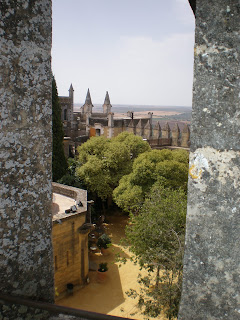El castillo de Almodóvar es una fortaleza militar de origen árabe que se edificó aprovechando una antigua edificación de épocas primitivas. Debido a su situación estratégica, está construida sobre una colina de 200 metros que domina el valle del Guadalquivir, esta fortaleza tuvo gran importancia en la defensa de Córdoba.
The castle of Almodóvar is a military fortress of Arab origin to be built taking advantage of an old building of primitive times. Due to its strategic location, is built on a hill 200 meters above the valley of the Guadalquivir River, this fort was very important in the defense of Cordoba.
Tras la reconquista por el rey Fernando III “El Santo”, el castillo es sometido a sucesivas ampliaciones por diferentes reyes castellanos: Pedro I de Castilla y Enrique de “Trastámara”. En 1629 es vendido por el rey Felipe IV a D. Francisco del Corral y Guzmán y desde entonces ha ido perteneciendo a la misma familia.
After the reconquest by Ferdinand III "The Saint", the castle has undergone successive expansions by different kings of Castile Peter I of Castile and Henry of "Trastámara." In 1629 sold by King Philip IV D. Francisco del Corral and Guzman and has since belonged to the same family.
After the reconquest by Ferdinand III "The Saint", the castle has undergone successive expansions by different kings of Castile Peter I of Castile and Henry of "Trastámara." In 1629 sold by King Philip IV D. Francisco del Corral and Guzman and has since belonged to the same family.
En la actualidad el castillo se conserva en un magnífico estado gracias a la restauración llevada a cabo por uno de sus propietarios, el XIIº Conde Torralva, D. Rafael Desmaissieres y Farina, restauración que se llevó a cabo a partir de 1901 y hasta 1936, que comenzó la Guerra Civil en España.
Today the castle is preserved in an excellent condition thanks to the restoration carried out by one of its owners, the first Count XII Torralva, D. Desmaissieres and Rafael Farina, restoration took place from 1901 until 1936, which began the Civil War in Spain.
Today the castle is preserved in an excellent condition thanks to the restoration carried out by one of its owners, the first Count XII Torralva, D. Desmaissieres and Rafael Farina, restoration took place from 1901 until 1936, which began the Civil War in Spain.
Huellas de múltiples culturas, fundamentalmente cristiana y musulmana, han ido marcando el estilo de esta fortaleza a lo largo del tiempo.
Traces of many cultures, mainly Christians and Muslims have been marking the style of this strength over time.
Aunque no todo el mundo está de acuerdo con las restauraciones y hay quienes piensan en que es mejor dejar los restos tal como y como han sido descubiertos o con la huella del tiempo marcando sus piedras, la vista de este castillo, por ejemplo, pone de manifiesto que una buena restauración, adaptándose a las formas y a los materiales originales, realizada con rigor, merece la pena y muestra los monumentos tal y como fueron en su momento, conservando y poniendo en valor lo que de otro modo quizás no serían más que un conjunto de piedras y restos de murallas que serían originales, sí, pero que seguramente transmitirían menos información con respecto al momento en que fueron habitadas.
Although not everyone agrees with restorations and some think it is better to leave the remains as as have been discovered or the passing of time marking their stones, the sight of this castle, for example, makes shows that a good restoration, adapting to the original forms and materials, conducted with rigor, it is worth and show the monuments as they were at the time, and place value on preserving what might otherwise be no more than one set of stones and remains of walls that would be original, yes, but surely transmit less information about the time they were inhabited.







No hay comentarios:
Publicar un comentario